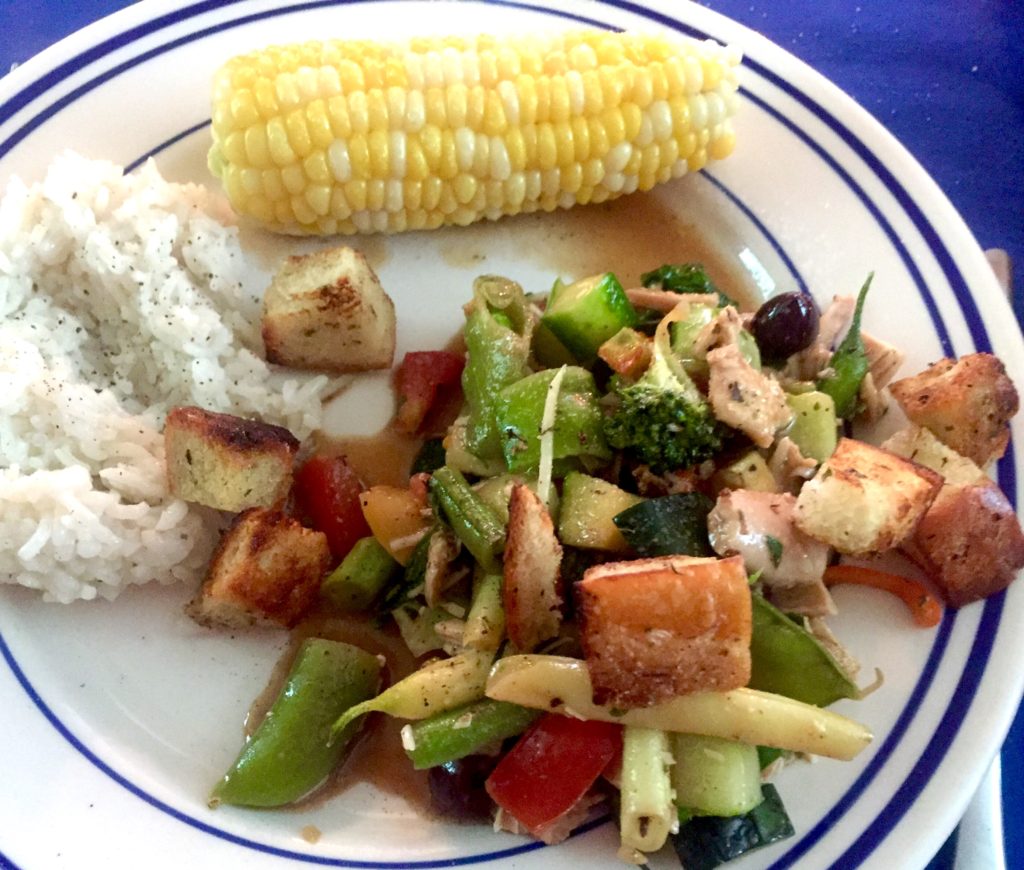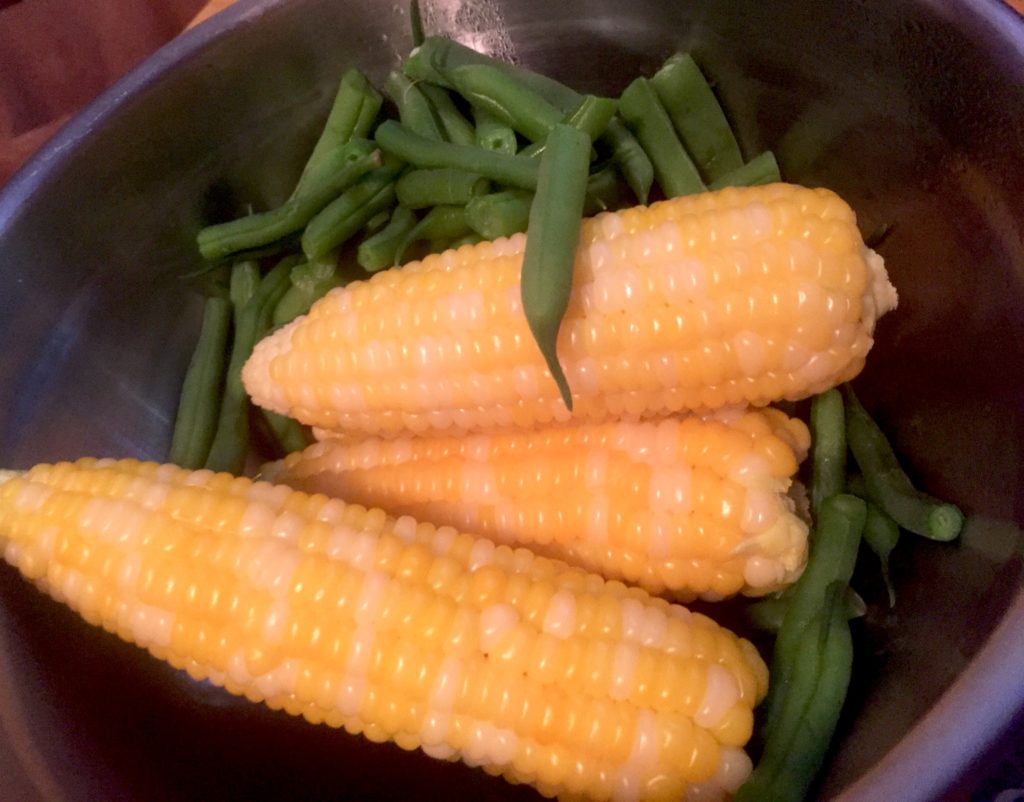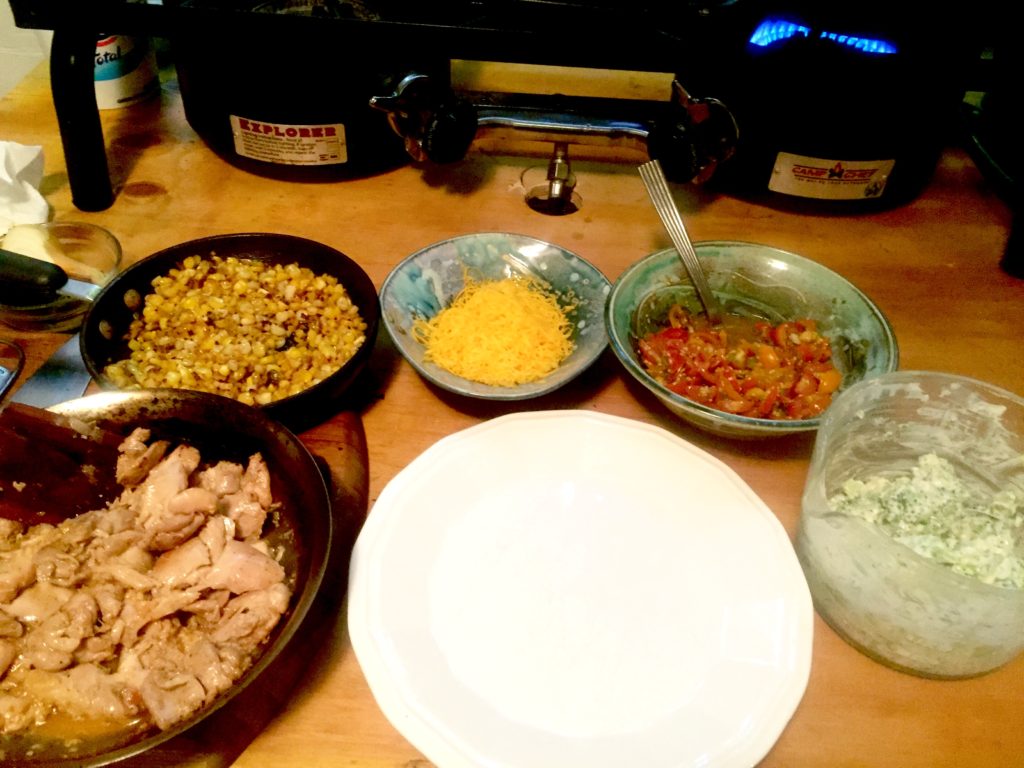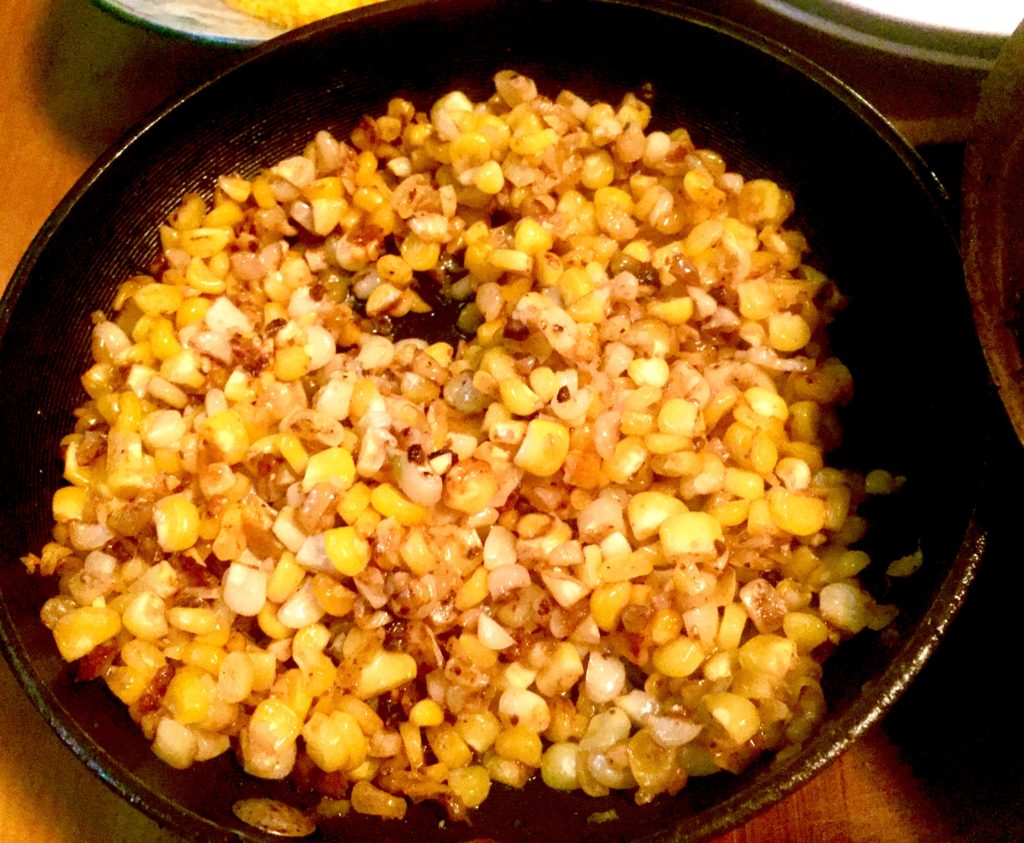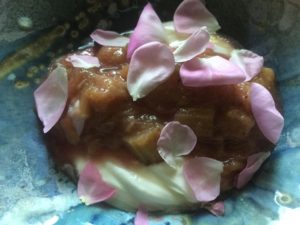I’m inspired to cook by food photos. By recipes. Food descriptions. People’s culinary stories. The aroma of garlic on the breeze. It’s my hope that these photos, descriptions, and stories will inspire you to cook as well.
Moving to San Diego has dramatically changed how I eat. I had finally adapted to the “eat it that day” freshness of Isla’s tropical climate, and we moved to San Diego, where I’m figuring out growing, shopping, and eating all over again.
We have a little garden space, and room for a few container gardens at our little house in North Park. So far we’ve grown: rainbow chard, green beans, cucumbers, lettuce, tomatoes, two kinds of snap peas, basil, mint, rosemary, exactly one potato, and some incredibly tenacious nasturtiums.
Other than the basil, chard, mint, and nasturtiums, there have been very small harvests of the other produce. However, I try to make sure that Callan eats at least one little thing from the garden each day. It’s a little ritual that makes me feel like I’m grounding us in place, however temporarily.
We’re moving again in less than a month. Our house is scheduled for demolition to make room for more apartments in these rapidly growing San Diego neighborhoods.
When we find our next home to settle in and make our own, I’ll plant seeds there too. Our family will watch them grow, and one afternoon we’ll walk out, pick a cucumber, and each take a bite.
Home, is where we grow.

Rainbow Chard and Blue Lake Bush Beans. I planted the beans in honor of my dad, who grows this variety at our home in Michigan.
I like to cook the beans lightly steamed so they still have a snap, and then give them a generous, delicious serving of butter and salt.
Chard is just, wonderful. The different colors even have different nutritional benefits.
- Add chard to stir fry
- Chop and sauté with olive oil. Add garlic and soy sauce/Braggs Liquid Aminos. Break a couple eggs on top and serve with toast. (Add balsamic and tomatoes—the options are endless).
- Add young chard to your green smoothie in the morning. (I like medium handful of chard blended with dragon fruit, lime juice, honey, and strawberries.
- Cook bigger chard like spinach or collard greens and serve as a side.

I bought a fancy salad spinner at the second hand store on University Ave. I’ve used it properly only a handful of times. Other than that it’s been worth it’s pennies as a most interesting toy that occupies Callan for minutes at a time.
- Mix the mint and lettuce. Add cucumbers and tomatoes with a balsamic/garlic/olive oil dressing and you have the perfect fresh salad for a hot summer night. (Oh, and add feta. Don’t forget cheese!)


Callan looked up and me and said, “Momma, can we have some pesto?”
My heart suddenly felt bigger.
My momma makes the most delicious fresh pesto. It’s a mostly-parsley pesto from fresh parsley she picks from the garden, washes, and puts right in the blender. It’s one of my favorite meals.
Our pesto pictured above was mostly basil with a few mint leaves thrown in.
To the blender we added:
- A couple handfuls of toasted walnuts (substitute sunflower seeds, pepitas, or pine nuts).
- A healthy dose of olive oil
- Salt and Pepper to taste
- Parmesan Cheese
- Blend everything together. Add to pasta, smear on bread, or add to scrambled eggs.

Enter, the roasting pan. Roasting vegetables is a great way to use veggies that are starting to get a bit past their prime.
For the Roasted Carrot soup pictured above, I roasted the carrots with salt and olive oil, then puréed them with a hand blender. I then put them in a sauce pan and added coconut milk, broth, spices, and garlic. The toppings are roasted pepitas and mix of chopped basil and mint.

We bought a bunch of beets and a bunch of carrots from The African Sister’s produce stand. The fresh carrots were as sweet as those from my father’s garden, which is a high compliment.
One of Callan’s favorites is when I roast beets and carrots together, and serve them with butter, salt, and either honey or a sweet balsamic reduction.

Make it fancy and top with some chopped egg, cucumber, and a garden nasturtium flower, which are edible and taste a bit spicy in a wasabi-kind of way.

Ryan looked up the best way to cook them, and decided on a quick sear and done.
That tuna was one of the best things I’ve ever eaten. It literally melted in our mouths with a delicate flavor complemented and lifted by salty soy sauce and spicy wasabi. I think I’m ruined from ever eating tuna in a restaurant again.


Luigi’s has become a Rickman-family favorite. My pizza is pesto with ricotta and green olives. Sometimes mushrooms. It’s amazing.






One of my favorite movies is “Julie and Julia,” about a food blogger who cooks her way through Julia Child’s cookbook. In one scene, the main character makes a truly stunning bruschetta with buttery toasted slices of baguette and juicy ripe tomatoes. She and her husband eat it in ecstasy, tomato juice and olive oil running down their hands, happy moans of pleasure the only sounds as they eat their way through the plate.
That was all I could think of when I saw those perfectly ripe tomatoes, and what I hoped to recreate here.
- Slather baguette slices in lots of butter (and/or olive oil). Sauté in a pan until golden brown.
- Mix together a finely minced garlic clove, diced fresh tomatoes, olive oil, salt and pepper to taste. You can also add diced herbs of your choice such as basil or thyme.
- Top the baguette slices with the diced tomatoes.
Close your eyes when you eat it, it’s so good. Think about the sun, warm on the skin of the tomato. Olive oil tang. Bread, yeasty crunch. All coming together, for a moment of perfection.


These crunchy, sweet, delicious cukes fit perfectly in a toddler’s hand, and are such a good snack.
We decided to grow them, and before the powdery mildew took over the few little plants, we enjoyed at least eight cukes picked right off the vine.
There’s nothing like it.
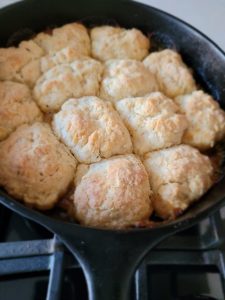
Another great way to use leftovers is to make a “casserole.”
I’m from the Midwest, and the word “casserole” covers a lot of ground. It’s also a great way to take a hodgepodge of leftovers and make them delicious again. Simply combine veggies and meat, cover with a bechamel, gravy, or other cream sauce.
From there, put into an oven-safe pan such as a cast iron Dutch oven.
You can cover it with a pie crust, or in my case I did a homemade biscuit crust. I have the worst time with pie crusts. But the biscuits were fluffy and delicious.

I, on the other hand, am a child of my parents, who eat any kind of leftovers scrambled into eggs or smooshed together on a plate and mopped up with bread. I’ve seen many different cultural cuisines find common ground on plates in my parents’ home.
As an adult, I’ve found my own love for leftover, squishy salads topped with an assortment of leftovers.
It creates a culinary balance in our household: new meals and leftovers. Everyone is happy.

I’ve lived a lot of places in my 37 years. I’ve grown many gardens, in various forms.
In our little North Park home, we planted all sorts of things in the nutrient-deprived, sun-blasted soil, with various degrees of success.
When I discovered a bag of sprouting potatoes at the back of the cupboard recently, my mind immediately went to memories of my father planting sprouting, wrinkled potatoes on humid spring afternoons in Michigan.
Currently, we had a dirt-filled planter on the porch, waiting for the symbiosis of roots, stem, and leaves.
With realistic hope I tucked the little round tubers, tentacled in sprouts, into the sub-par soil that was affordable but didn’t offer much for nutrients.
Against my expectations, one, two, four, six little potato plants sprouted and grew to about four or five inches before lack of nutrients and some pest I couldn’t identify caused them to stop growing and slowly crumble into brown-leafed-nothingness.
The wilted plants didn’t look very good next to the front door, so I began pulling them up one afternoon. The second plant yielded, but with difficulty.
From the bottom of the wilted stalk dangled one, single, perfect potato.
Despite the slow demise of the top part of the plant, the roots were continuing to do what they do: make potatoes.
In the face of yet another move, and more change in our lives, there’s something about the tenacity of that little potato plant that won’t leave my mind.
We held it up in wonder. The strange, wrinkled tuber at the bottom of the bag in the back of the cupboard that normally would have been thrown away, tucked into soil, sprouted, and created a replica of its genes.
Maybe it’s a bit off, to find meaning in a single, solitary potato grown on a front porch planter, but if the last year and a half has shown me anything, it’s to take life’s little miracles where we can find them.
A potato seems as good a place as any.






















